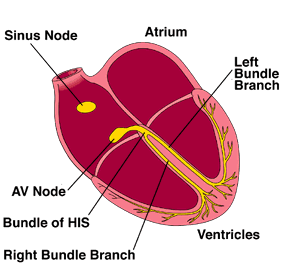

Basic concepts --
Normal heart rates
Sinus bradycardia
Sinus Tachycardia
Premature atrial contractions
("PAC's")
Premature ventricular
contractions ("PVC's")
Paroxysmal supraventricular
tachycardia ("PSVT")
Wolff-Parkinson-White
Syndrome ("WPW")
Atrial fibrillation
Atrial flutter
"Sick sinus syndrome"
and "tachy-brady" syndrome
Slow
heart rhythms
Bundle Branch Blocks
Basic concepts -- Normal heart
rates
A "normal" heart rate is defined as anywhere
from 60 to 100 beats per minute at rest. These numbers are pretty arbitrary,
and many people have slower or faster rates than this and are still "normal".
The range of normal, counting sleep and daytime activities, is around 45-95.
Slow heart rates are called "bradyarrhythmias", and fast heart rates are known as "tachycardias".
The heart rate varies widely throughout the day depending on the activity one is engaged in. There are other factors that are less well defined, such as "circadian rhythms" that change the overall rate of the body's, as well as the heart's metabolism. Appropriate variations in heart rate are actually a sign of a healthy heart.
A slow rate is particularly common among active people such as athletes. Many people are "just born with" a slow heart rate. There is not necessarily anything wrong with having a rate less than 60 beats per minute. In fact, most people's heart rate goes lower than 60, and may even go as low as 30-40 beats per minute, when they sleep. Physical activities or emotional excitement, typically cause rates greater than 100.
Sinus bradycardia
In this condition, the sinus node sets the pace
for the rest of the heart just like it usually does, but it does it more
slowly than usual. As noted above, this can be, and is usually, entirely
normal even when quite exaggerated.
However, this slowing of the heart rate can also be abnormal. If the rate is too slow for a given person, then symptoms such as lightheadness or passing out ("syncope") may occur. Patients may have symptoms of congestive heart failure or may experience chest pains.
Some of the conditions associated with abnormal sinus bradycardia include the "Sick Sinus Syndrome" (which is also discussed more fully below), a condition in which different parts of the conduction system appear to simply "wear out". Slowing of the heart rate can be caused from conditions outside of the heart such as a low thyroid. Marked slowing of the heart rate during sleep is one of the symptoms of obstructive Sleep Apnea (along with loud snoring, periods of not breathing, and other findings).
Slow heart rates can be caused or worsened by medications, including:
The treatment involves correction of any underlying conditions
which may exist (such as supplementing the thyroid) and reducing or discontinuing
any drugs which may be worsening the problem. If persistent bradycardia
and symptoms are present, a pacemaker may be indicated.
Sinus Tachycardia
This is the condition where the sinus node starts
the heart going at a more rapid rate (by definition, over 100 beats per
minute). It is a normal response to increased demands on the heart, such
as exercise or other stress. It can also occur in other situations, such
as:
Premature atrial contractions
(PAC's)
PAC's are beats which originate in parts of the
atrium other than the sinus node. These impulses occur prematurely, before
the sinus node depolarizes. They are conducted through the atrium and slow
down, just like a normal sinus beat, when they reach the A-V node. They
are conducted through the ventricle in the same fashion as a normal sinus
beat.
These are very common, and can be completely unknown to
the person, or perceived as a "skip" or a "pause". They
may be caused by many of the same conditions as noted for sinus tachycardia
above, and are not necessarily an indication of any disease at all. Follow
the general measures for palpitations [link]. Treatment with beta-blockers,
calcium-channel blockers or other agents can be useful.
Premature ventricular contractions
(PVC's)
These are also extremely common. These arise in
the lower chambers of the heart, and are associated with many of the same
causes as PAC's and sinus tachycardia. They are sometimes viewed with more
concern, since multiple consecutive PVC's (ventricular tachycardia) can
be associated with serious heart problems and sudden death. However, the
vast majority are benign, and do not require treatment. Further testing
may be warranted.
Stay tuned to HeartPoint for more on ventricular arrhythmias
in the near future.
Paroxysmal supraventricular
tachycardia ("PSVT")
In this situation, rapid heart beats occur which
arise in tissues above the ventricles. There are actually several specific
mechanisms which cause this disorder, most of which are associated with
"short circuits" within the heart muscle. A relatively small amount
of tissue is involved which allows electricity to go around-and-around quickly
(120-250 beats per minute) and spread to the rest of the heart muscle.
This may begin at any age. It can occur in otherwise normal hearts.
These rhythms are generally responsive to a variety of medications such as calcium channel blockers, beta blockers, digoxin, or others. Often "perfect control" is not possible, but substantial improvement can be obtained.
In cases of these arrhythmias which are unresponsive to
medications, or in the case of very fast rates, further testing with electrophysiologic
studies may be indicated.
Wolff-Parkinson-White Syndrome
("WPW")
This disorder, which is named after three prominent
early investigators, involves a "bypass tract". This bypass is
not the sort associated with blocked arteries -- rather, it is a band of
tissue that penetrates directly from the atrium to the ventricle (remember,
this area that is usually electrically completely "blocked" by
fibrous tissue). Due to the presence of this bypass tract, the electrical
activity can pass directly from the atrium to the ventricle without pausing
at the AV node. Of even greater importance is the fact that a "re-entrant
circuit" is set up, where electrical activity can pass around the loop
involving the atrium, the bypass tract, the ventricle, and the AV node in
such a way that very rapid tachycardias can result.
The arrhythmias from WPW may resemble more ordinary arrhythmias, but often require different medications. Great advances have been made in the field of electrophysiology, the study of cardiac electricity, particularly in the diagnosis and treatment of WPW. The location of the bypass tract can be identified, and in many cases can be "ablated" (destroyed) using radiofrequency delivered via a relatively catheter-based technique.
Atrial fibrillation
Atrial fibrillation is a very common arrhythmia.
In this arrhythmia, the upper chambers of the heart fail to maintain a regular
pattern of depolarization. The electrical impulse moves randomly throughout
the tissue, and the mechanical contraction of the upper chambers is lost.
This arrhythmia may exist, and the patient may feel absolutely
fine. Some feel only palpitations. Others may be highly symptomatic and
suffer chest pains, lightheadedness or congestive heart failure in association
with the arrhythmia. One of the most important aspects of atrial fibrillation
is that it is associated with an increased risk of suffering a stroke, from
the buildup of clot in the non-contracting atrium. We will devote an entire
section to this interesting and difficult to treat arrhythmia in the very
near future.
Atrial flutter
This arrhythmia is closely related to atrial fibrillation.
In this arrhythmia, the atria beat regularly, but at an extremely high rate,
generally around 300 beats per minute. While the atria can tolerate this
reasonably well, the lower chambers (ventricle) cannot. Fortunately, the
AV node is present to slow down and diminish the number of impulses which
pass through to the ventricle. There is the fortunate production of a block
at the level of the AV node, generally allowing only one of every two or
three or four of the flutter wave to be passed down to the ventricle. Other
and less regular ratios of blocked beats may occur.
Otherwise very similar to atrial fibrillation, atrial flutter
by itself is not felt to be associated with clots since there is some mechanical
efficiency to keep the blood flowing in the atrium. It is treated in a similar
manner, but since clots are not a feature, complete control of the arrhythmia
is generally not as important unless the patient is highly symptomatic.
Atrial flutter can be treated by interrupting some of the pathways using
catheters that deliver radio frequency energy ("Radiofrequency ablation"),
thus minimizing or doing away with the needs for medications.
"Sick sinus syndrome"
and "tachy-brady" syndrome
A "syndrome" in medicine is a collection
of characteristics that define common findings in a group of patients. It
is not a "disease" in itself, but may reflect other disease entities.
Patients with "Sick Sinus Syndrome" (SSS) share having a variety
of arrhythmias, primarily involving the upper chambers of the heart and
AV node. They may have fast or slow rhythms involving these structures,
and if they have both rapid and slow varieties, patients are often said
to have "tachy-brady syndrome". Patients with SSS may also have
atrial fibrillation, atrial flutter and other arrhythmias as well.
The initial descriptions many years ago focused on the
fact that the sinus node did not seem to be doing it's job, but as study
has continued, it has become clear that this is a disease that may involve
much of the conduction system of the heart. Many people have what appears
to be problems almost entirely with fast (or "tachy") rhythms.
However, when these arrhythmias are treated with agents to slow the heart
down, it becomes apparent that they are very sensitive to these agents,
and may have dramatic slowing of the heart rate, much more than one would
generally expect in other patients. If a satisfactory balance of medications
cannot be found, and this is not uncommon, a pacemaker often needs to be
placed to prevent the heart from going too slow when given medications to
prevent it from going too fast.
Other slow heart rhythms
Most of the rhythms noted above are rhythms that
go too fast. What about rhythms that are too slow? These are rhythms that
occur generally for one or both of the following reasons:
These abnormalities are common, and may be caused or worsened
by certain medications, including "over-the-counter" drugs. Treatment
is removal of any offending agents or correction of any medical conditions
which may be making this worse. If this is not successful, a pacemaker may
be necessary and be quite beneficial.
Bundle Branch Blocks
These really aren't arrhythmias, but are alterations
in the way the lower chambers of the heart are activated. The bundle branches
(there is one on the left and one on the right) bring the electrical impulses
down from the AV Node to the ventricles, and are illustrated and labelled
on the graphic at the beginning of this section. Bundle Branch Blocks simply
result in the electrical activity spreading from cell to cell. By itself,
this method of electrical activity is not of any particular consequence.
Another variation of this are the "hemiblocks" or "fascicular blocks". These refer to the two halves of the left bundle. There is an "anterior fascicle" and a "posterior fascicle". These may be considered the same as a left or right bundle branch block when considering their cause and basic approach to management.
Bundle Branch Blocks may be present from birth, and people can simply live a long and normal lifespan with the condition. Perhaps it is only found on an electrocardiogram done for some other or routine purpose.
It may also be associated with other conditions, and if it suddenly "appears", your doctor may very well wish to do further testing to make sure it is not associated with any other problems.
By itself, a bundle branch block doesn't imply that a pacemaker will be needed, unless there are other associated medical or rhythm situations which will influence such a decision.
For more about Arrhythmias, also see these related subjects on HeartPoint:
©1997 HeartPoint Updated October 1997
